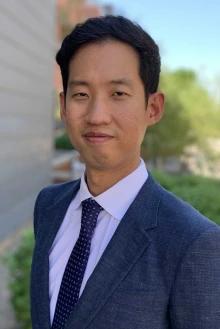Do air pollution and extreme temperatures increase 911 emergency calls?
Public health researcher Chris Lim, PhD, received a $1.6 million National Institutes of Health grant to investigate whether environmental changes impact emergency medical services.

University of Arizona Health Sciences researchers will study whether there is a correlation between environmental exposures, such as air pollution and extreme temperatures, and emergency medical transport calls.
Photo by FangXiaNuo via Getty Images
Researchers at the University of Arizona Mel and Enid Zuckerman College of Public Health will use air quality sensors, temperature measurements and a national database of 911 emergency medical services calls to evaluate the links between environmental exposures, such as air pollution and temperature, and EMS transports for health emergencies.
Emergency medical services represent a critical facet of the public health infrastructure that could be increasingly stressed by climate change, but the nationwide burden on EMS systems associated with environmental exposures remains unknown.

Chris Lim, PhD
Zuckerman College of Public Health
“Our climate is becoming hotter and more unpredictable, and that leads to elevated levels of air pollution and extreme temperatures that have dangerous health effects,” said lead researcher Chris Lim, PhD, an assistant professor at the Zuckerman College of Public Health. “This research will measure those effects by connecting these datasets with a new level of detail on air quality, temperature, time, place and built environment. This data will guide our decisions on how to make our health care infrastructure more resilient as our climate changes.”
The study, “Short-Term Environmental Exposures and Emergency Medical Service Activation in the United States,” is funded by a $1.6 million grant from the National Institute of Environmental Health Sciences, a division of the National Institutes of Health.
Current data on the associations between environmental exposures and EMS transports does not provide sufficient detail needed to assess the risk factors and inform EMS planning, programs and policy. Lim uses new sensor technologies and big data to examine health risks in urban environments and determine how to mitigate those risks.
The study will leverage the National Emergency Medical Services Information System, a national database of 911 calls, to test the hypothesis that short-term air pollution and temperature exposures are associated with EMS transports.
Researchers hope to link 911 calls with neighborhood characteristics and environmental exposures, including fine particulate matter, nitrogen dioxide, ozone, temperature average and temperature variability, for the years 2017 to 2023 and beyond.
They also will evaluate short-term associations between environmental exposures and cause-specific EMS transports such as all cause, cardiovascular, respiratory, temperature-related and injuries. Finally, using low-cost sensors and population mobility datasets, they will examine the associations between exposures and EMS outcomes in select urban areas.
“I’m so pleased to learn about this funding for Dr. Lim’s innovative environmental exposures research,” said Iman Hakim, MD, PhD, MPH, dean of the Zuckerman College of Public Health. “Our college has unique expertise in climate change and health, and this data will enhance our knowledge of environmental exposures and our ability to respond to these emerging climate-driven health threats here in Arizona and around the country.”
Co-investigators include University of Illinois Chicago researchers Lynn Gerald, PhD, MSPH, a research professor of medicine and the assistant vice chancellor for population health sciences, and Honghyok Kim, PhD, MPH, an assistant professor of environmental and occupational health sciences; University of Utah researchers N. Clay Mann, PhD, MS, MBA, a professor of pediatrics, and Jonathan Race, PhD, an assistant professor of pediatrics; and Ran Wei, PhD, MS, an associate professor of public policy at the University of California, Riverside. Xiaojiang Li, PhD, MA, an assistant professor of urban spatial analytics at the University of Pennsylvania, will serve as consultant for the study.
Expert
Chris Lim, PhD
Assistant Professor, Department of Community, Environment and Policy, Mel and Enid Zuckerman College of Public Health
Contact
Shipherd Reed,
Mel and Enid Zuckerman College of Public Health
520-626-9669, shipherd@arizona.edu

